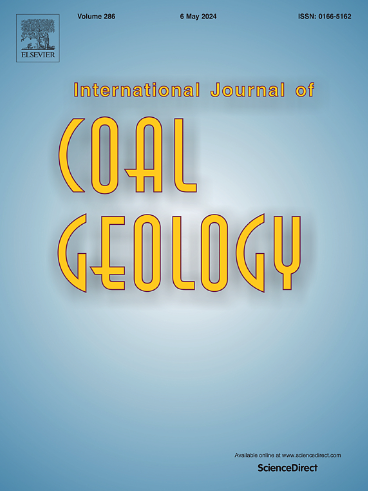Geochemical and petrological characteristics coupled with stable isotope of the Permian Gondwana coals from Tatapani–Ramkola Coalfield, Son–Mahanadi Basin, India: Insights for paleodepositional and paleoclimate conditions
IF 5.7
2区 工程技术
Q2 ENERGY & FUELS
引用次数: 0
Abstract
This study aimed to investigate the quality and rank of the Tatapani-Ramkola coal and decipher the paleoclimate and depositional conditions during coal formation, explicitly focusing on vegetation sources, detrital contributions, and paleomire conditions. The studied coals exhibit a moisture between 4.0 % and 12.8 % and a volatile matter yield in the range of 28.8–49.5 wt% (dry ash–free basis), classifying them as subbituminous–A to bituminous in rank. This finding is supported by the vitrinite reflectance (VRo) values between 0.5 and 0.7 %. Maceral compositions reveal the dominance of vitrinite (average 47.8–62.4 %) followed by inertinite (average 13.0–29.9 %) and liptinite (average 8.5–13.1 %). This finding of the maceral characteristics together with the mineral composition (primarily clay, carbonate, and sulfide), show that the Tatapani–Ramkola coals were formed under mildly oxic–to–anoxic conditions in limno–telmatic to telmatic paleomires and contributions from forest and herbaceous vegetation. Geochemical isotope indicators, such as δ13C (−24.149 ± 0.825 ‰) and δ15N (+2.710 ± 0.344 ‰), suggest that the coals formed from C3 land plants under warm and humid climate conditions. Major oxide ratios indicate a moderate to high degree of chemical weathering in the source area, further confirming the prevailing warm and humid climate during the peat accumulation. The detrital/authigenic index (DAI) suggests significant detrital influence and authigenic sediment formation in the Tatapani–Ramkola coals. This study provides critical insights into the depositional history and paleoclimate of the Tatapani–Ramkola Basin, contributing to a deeper understanding of Permian coal formation processes.
印度Son-Mahanadi盆地Tatapani-Ramkola煤田二叠系Gondwana煤的地球化学和岩石学特征及稳定同位素特征:古沉积和古气候条件的启示
本研究旨在研究Tatapani-Ramkola煤的质量和等级,揭示成煤时期的古气候和沉积条件,明确关注植被来源、碎屑贡献和古沉积条件。所研究的煤的水分在4.0% ~ 12.8%之间,挥发物产率在28.8 ~ 49.5 wt%(干无灰基)之间,按等级将其分类为亚沥青- a至沥青。镜质组反射率(VRo)值在0.5 ~ 0.7%之间,支持了这一发现。显微成分以镜质组为主(平均47.8 ~ 62.4%),其次为惰质组(平均13.0 ~ 29.9%)和脂质组(平均8.5 ~ 13.1%)。显微特征和矿物组成(主要是粘土、碳酸盐和硫化物)表明,塔塔帕尼-拉姆科拉煤是在轻度氧-缺氧条件下形成的,并有森林和草本植被的贡献。δ13C(−24.149±0.825‰)和δ15N(+2.710±0.344‰)等地球化学同位素指标表明,煤形成于温暖湿润气候条件下的C3陆生植物。主要氧化比表明源区化学风化程度中等至高度,进一步证实了泥炭堆积时期普遍存在的温暖湿润气候。碎屑/自生指数(DAI)表明Tatapani-Ramkola煤中存在明显的碎屑影响和自生沉积形成。该研究为塔塔帕尼-拉姆科拉盆地的沉积历史和古气候提供了重要的见解,有助于更深入地了解二叠纪煤的形成过程。
本文章由计算机程序翻译,如有差异,请以英文原文为准。
求助全文
约1分钟内获得全文
求助全文
来源期刊

International Journal of Coal Geology
工程技术-地球科学综合
CiteScore
11.00
自引率
14.30%
发文量
145
审稿时长
38 days
期刊介绍:
The International Journal of Coal Geology deals with fundamental and applied aspects of the geology and petrology of coal, oil/gas source rocks and shale gas resources. The journal aims to advance the exploration, exploitation and utilization of these resources, and to stimulate environmental awareness as well as advancement of engineering for effective resource management.
 求助内容:
求助内容: 应助结果提醒方式:
应助结果提醒方式:


